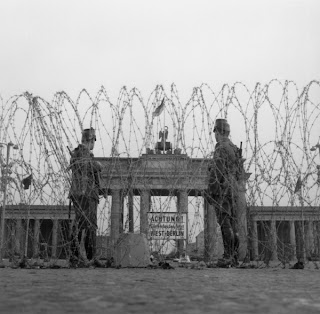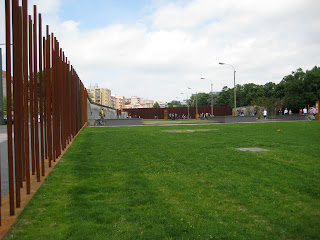After years of rising rhetoric, aggressive threats, intimidation and arrests, the Soviet Union made official the split between East and West Berlin. On August 13, 1961, sharp barbed wire wended through the heart of the city, with stone-faced soldiers guarding the new border. The Brandenburg Gate, once the marker to a thriving city center, now stood in a no-man's-land that wouldn't be crossed for 28 years. That wire became the Berlin Wall.
 |
| Soviet soldiers guard the barbed wire, that would become the Berlin Wall, trapping the Brandenburg Gate behind it. |
From John F. Kennedy ("Ich bin ein Berliner!") to Ronald Reagan ("Tear down this wall!"), American presidents railed against the "evil empire," keeping the Soviet Union and the Wall within their sites. West Berlin became an isolated republic of sorts; its citizens, though surrounded by East Germany and mere steps away from Eastern Europe, traveled freely from the Soviet Bloc to West Germany and beyond. East Berlin, meanwhile, took its place among the stunted cities seething behind the Iron Curtain.
 |
| The Brandenburg Gate stands isolated and is disrepair in a no man's land breached by few (1977). Photo courtesy berlin-wall.org. |
The Berlin Wall was in fact two walls in many places along its route, two concrete snakes jealously guarding their territories. To discourage defectors, East Germany reinforced the Wall many times over, increasing its height, adding a rounded top to eliminate climbers' grip, then barbed wire atop that curve. The guard towers standing between the two walls were constantly manned by ever watchful Russian and East German soldiers. Many East Berliners lost their lives trying to cross from East to West.
Twenty-eight years later, the Wall came down. In bits and pieces, Berliners from both sides of the divide tore chunks from the reinforced walls, daring Moscow to stop them. Soviet guards stood by, keeping their guns lowered as people scrambled through the enlarged holes in the Wall and jumped up in jubilation as they entered the forbidden west side. By November 1989, it was official: The Berlin Wall was no more—if more psychologically than physically—and the city and Germany started marching toward reunification.
 |
| Soviet soldiers half-heartedly stand their ground as Berliners tear down a segment of the wall in 1989. |
The Berlin Wall crumbled bit by bit, and today little of the physical walls actually remain. A line through much of the city's center marks where parts of the Wall once stood. The Mauer neighborhood (the German word "mauer" literally means "wall") hosts the last large segment of the border, and a memorial park now stands in the former no-man's-land. The city's grid has been restored (as it were—Berlin developed in a haphazard way, reflecting the different ambitions of the royal families that took up residence in the 19th century), and neighborhoods east and west are thriving, full of energy and tourists. All seems well and healed, as development fueled by the German economy and foreign investment pounds on.
 |
| The line marking where the Berlin Wall once stood in Potsdamer Platz |
 |
| One of the very few watchtowers from the era of the Wall, near Potsdamer Platz. |
 |
| A surviving section of the Wall. Several stand scattered near one of Berlin's business districts. |
Yet scars remain. What the Berlin Wall wrought was a psychological split so deep that many Berliners of a certain age long for the days of separation and the predictability of Soviet life. There are still others who have never crossed the "boundary" into the sister part of the city, remaining rooted in a comforting if stale past or frightened by the uncertainty of democracy and the jolting crests and troughs of capitalism. A writer, raised in East German, recently posited that it would take another generation to truly obliterate
the effects of the Berlin Wall. He may be right. But hope springs eternal, and it is to this hope that I choose to cling.
 |
| The largest surviving segment of the Berlin Wall, in the Mauer neighborhood |
 |
| A memorial park now occupies a former no man's land behind the wall segment. |
 |
| Looking east (second from above), then west. from the memorial park. This is the only street not restored to its pre-1961 state. |
 |
| For young Berliners and tourists, this Wall Museum (one of several in the city) is as close as they'll come to the real thing, a segment of which remains across the street. |
















Isn't Berlin great? I went in May 2010 and fell in love...
ReplyDeleteThe politics, the history, the arts and design scenes--all made Berlin a fascinating, energetic and complicated place. Worth the trip.
ReplyDelete